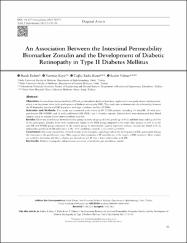| dc.contributor.author | Erdem, Burak | |
| dc.contributor.author | Kaya, Yasemin | |
| dc.contributor.author | Kıran, Tuğba Raika | |
| dc.contributor.author | Yılmaz, Saadet | |
| dc.date.accessioned | 2023-12-26T08:37:01Z | |
| dc.date.available | 2023-12-26T08:37:01Z | |
| dc.date.issued | 2023 | en_US |
| dc.identifier.citation | Erdem, B., Kaya, Y., Kıran, T.R., Yılmaz, S. (2023). An Association Between the Intestinal Permeability Biomarker Zonulin and the Development of Diabetic Retinopathy in Type II Diabetes Mellitus. Turkish Journal of Ophthalmology, 53 (2), pp. 91-96.
https://doi.org/10.4274/tjo.galenos.2022.70375 | en_US |
| dc.identifier.issn | 2147-2661 | |
| dc.identifier.issn | 2149-8709 | |
| dc.identifier.uri | https://doi.org/10.4274/tjo.galenos.2022.70375 | |
| dc.identifier.uri | https://hdl.handle.net/20.500.12508/2808 | |
| dc.description.abstract | Objectives: Increased intestinal permeability (IP) and gut microbiota dysbiosis have been implicated in low-grade chronic inflammation, which is an important factor in the pathogenesis of diabetic retinopathy (DR). This study aims to demonstrate the relationship between the IP biomarker zonulin and DR in patients with type 2 diabetes mellitus (T2DM). Materials and Methods: This study was conducted with a total of 89 T2DM patients, including 33 non-DR, 28 with non -proliferative DR (NPDR), and 28 with proliferative DR (PDR), and 32 healthy controls. Zonulin levels were determined from blood samples using an enzyme-linked immunosorbent assay kit. Results: There was no difference between the four groups in terms of age (p=0.236), gender (p=0.952), and body mass index (p=0.134) of the participants. Zonulin levels were significantly higher in the PDR group compared to the other three groups, as well as in the non-DR and NPDR groups compared to the control group. In multivariate logistic regression analysis, zonulin was found to be an independent predictor of DR (odds ratio: 1,781, 95% confidence interval: 1,122-2,829, p=0.014). Conclusion: Our study showed that elevated zonulin levels may play a significant role in the development of DR, particularly during the transition to the proliferative stage. This suggests that regulation of IP could be one of the targets of DR treatment. More studies are needed to determine whether a eubiotic gut microbiota and IP have a direct relationship with DR. | en_US |
| dc.language.iso | eng | en_US |
| dc.publisher | Turkish Ophthalmology Society | en_US |
| dc.relation.isversionof | 10.4274/tjo.galenos.2022.70375 | en_US |
| dc.rights | info:eu-repo/semantics/openAccess | en_US |
| dc.subject | Biomarkers | en_US |
| dc.subject | Diabetes mellitus | en_US |
| dc.subject | Type 2 | en_US |
| dc.subject | Diabetic retinopathy | en_US |
| dc.subject | Humans | en_US |
| dc.subject | Permeability | en_US |
| dc.subject.classification | Haptoglobins | |
| dc.subject.classification | Haptoglobin-Hemoglobin Complex | |
| dc.subject.classification | Human HP Protein | |
| dc.subject.classification | Clinical & Life Sciences
- Inflammatory Bowel Diseases & Infections
- Gut Microbiota | |
| dc.subject.other | Microbiota | |
| dc.subject.other | Pathogenesis | |
| dc.subject.other | Diabetic retinopathy | |
| dc.subject.other | Gut microbiota | |
| dc.subject.other | Inflammation | |
| dc.subject.other | Intestinal permeability | |
| dc.subject.other | Zonulin | |
| dc.subject.other | Biomarkers | |
| dc.subject.other | Diabetes mellitus | |
| dc.subject.other | Type 2 | |
| dc.subject.other | Diabetic retinopathy | |
| dc.subject.other | Humans | |
| dc.subject.other | Permeability | |
| dc.subject.other | Creatinine | |
| dc.subject.other | Hemoglobin A1c | |
| dc.subject.other | High density lipoprotein cholesterol | |
| dc.subject.other | Low density lipoprotein cholesterol | |
| dc.subject.other | Tight junction protein | |
| dc.subject.other | Triacylglycerol | |
| dc.subject.other | Unclassified drug | |
| dc.subject.other | Zonulin | |
| dc.subject.other | Biological marker | |
| dc.subject.other | Body mass | |
| dc.subject.other | Controlled study | |
| dc.subject.other | Diabetic retinopathy | |
| dc.subject.other | Diagnostic test accuracy study | |
| dc.subject.other | Disease association | |
| dc.subject.other | Disease duration | |
| dc.subject.other | Enzyme linked immunosorbent assay | |
| dc.subject.other | Female | |
| dc.subject.other | Human | |
| dc.subject.other | Intestine mucosa permeability | |
| dc.subject.other | Male | |
| dc.subject.other | Middle aged | |
| dc.subject.other | Non insulin dependent diabetes mellitus | |
| dc.subject.other | Nonproliferative diabetic retinopathy | |
| dc.subject.other | Post hoc analysis | |
| dc.subject.other | Predictive value | |
| dc.subject.other | Proliferative diabetic retinopathy | |
| dc.subject.other | Receiver operating characteristic | |
| dc.subject.other | Sensitivity and specificity | |
| dc.subject.other | Complication | |
| dc.subject.other | Diabetic retinopathy | |
| dc.subject.other | Permeability | |
| dc.title | An Association Between the Intestinal Permeability Biomarker Zonulin and the Development of Diabetic Retinopathy in Type II Diabetes Mellitus | en_US |
| dc.type | article | en_US |
| dc.relation.journal | Turkish Ophthalmology Society | en_US |
| dc.contributor.department | Mühendislik ve Doğa Bilimleri Fakültesi -- Biyomedikal Mühendisliği Bölümü | en_US |
| dc.identifier.volume | 53 | en_US |
| dc.identifier.issue | 2 | en_US |
| dc.identifier.startpage | 91 | en_US |
| dc.identifier.endpage | 96 | en_US |
| dc.relation.publicationcategory | Makale - Uluslararası Hakemli Dergi - Kurum Öğretim Elemanı | en_US |
| dc.contributor.isteauthor | Kıran, Tuğba Raika | |
| dc.relation.index | Web of Science - Scopus - PubMed | en_US |
| dc.relation.index | Web of Science Core Collection - Emerging Sources Citation Index | |
















